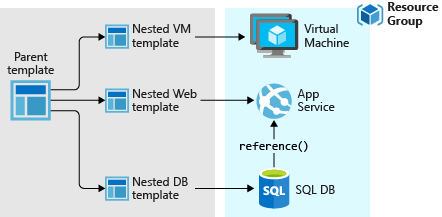Modularisation of Terraform and ARM Templates
- Terraform on Azure
- Deployments with Terraform and ARM Templates
- Modularisation of Terraform and ARM Templates
- Dependencies in Terraform and ARM Templates
- Terraform Calling ARM Templates
- Terraform with Azure DevOps: Setup
- Terraform with Azure DevOps: Key Vault Secrets
- Terraform Modules and Code Structure
- Terraform and Azure DevOps Tips and Tricks
Modularised Deployment Definition
When it comes to code, everyone loves reuse. DRY is a great principle to follow for any elements of your work and IaC is no exception. Having a modularised deployment definition for resources that is centrally managed, parameterised to allow amending for different deployment scenarios/environments provides massive benefits. So let’s take a quick look at how we achieve modularisation of ARM Templates and Terraform.

ARM Templates
Linked/Nested Templates
ARM allows the calling of templates within templates, using links to other templates within a parent template. This means we can use a modularised deployment definition by separating out across multiple files for ease of maintenance and reuse. There is one rather annoying requirement for this however, and this is that the linked file needs to be accessible from Azure’s deployment executor at the time of deployment. This means storing the templates in a location accessible from within Azure, such as a blob storage account. If we are to use linked templates, we then need to manage the deployment of the files to this location as a prerequisite to the deployment execution. We also can’t ‘peak’ into these files to validate any content or leverage any intellisense from within tools.
Close Coupled Parameter Files
The close coupling of ARM Template parameters with parameter files that we mentioned in the post Deployments with Terraform and ARM Templates does provide some challenges when it comes to centralising definitions across a complete deployment. As previously mentioned, we can include only those parameters within the file that are expected by the respective ARM template. This prevents us from using a single file for all parameters should we desire to do so.
Template Outputs
ARM does allow us to define outputs from linked/nested templates that can be passed back to parent templates. This is useful for items such as Resource IDs and other deployment time values.
Terraform
Terraform Modules
Terraform .tf files can be directly referenced from other modules. You can defined one or more .tf files within a directory, with an associated variable definition file if desired. A simple example of referencing one module from another is shown below.
module "network" {
source = "./modules/vpn-network"
address_space = "10.0.0.0/8"
}
Here we are setting an argument for the referenced resource (an ‘azurerm_virtual_network’) address_space as required from within the referencing module. We can also pass in the values for any predefined variables using the same syntax as we have done above for the resource argument, using the variable name rather than the name of a resource argument.
The module references can done using relative local paths, git/GitHub repositories, centralised Terraform registries (public or private), HTTP urls and Azure storage/Amazon S3/GCS Buckets. This offers pretty much any solution to centralised storage that administrators might want to leverage. It also provides a more flexible modularised approach to deployment definition than that offered by ARM templates. Any required modules are acquired as required by the Terraform executor machine within the initialisation stage using the ‘Terraform Init’ action.
The management of these modules is no more complex than managing any code artifacts within your organisation. No concerns over missing redeployment of linked files, and a great selection of options for centralised management. For me this is a big benefit for deployments that involve anything beyond the most basic of resources.
Deployment-Wide Variable Files
Terraform allows variable files to contain all variables required by the deployment with no issues for redundant entries. Variables can be passed in to other Terraform modules as required allowing you to practice concepts such as ‘dependency inversion’, whereby the called module accepts input from the calling module and has no care for what the calling module passes.
Module Outputs
Each Terraform module can also supply outputs, thereby allowing passing back of resultant items such as Resource IDs and the like (as with ARM templates), for use in the calling module.
Conclusion
The modularisation of Terraform and ARM Templates use different approaches that provide varying levels of reuse and centralised management. The linked/nested templates provided by ARM Templates lack the flexibility of referencing and storing that are provided by Terraform. The additional steps required to ensure that the linked files are in place when needed does present a source of potential deployment failure. Terraform’s ability to retrieve modules from pretty much any repository type offers considerable advantages. When coupled with the less restrictive use of variables compared to ARM parameters, Terraform comes out clearly on top in this area.
You can find a great guide on IaC best practices using Terraform and Azure from Julien Corioland of Microsoft at https://github.com/jcorioland/terraform-azure-reference.



About the author